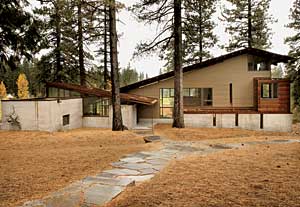Lake Tahoe, Nevada
The notion of a camp compound appealed to the project’s client, an active family wanting to be outdoors as much as possible at their vacation home near the north shore of Lake Tahoe, Nevada. This underlying design concept allowed the architect, David Lake, FAIA, of Lake/Flato Architects in San Antonio, to spread out the program and divide its components among three buildings sited along the edge of the 3⁄4-acre tract. The strategy also protected the site’s most distinctive features, particularly its towering Ponderosa pines. “It was a way of preserving the character of the site and leaving as much open space as possible,” says Lake.
The multibuilding plan loosely forms a courtyard that slopes downward and culminates in a 2,950-square-foot, three-story main house, referred to as the lodge, which consists of a kitchen; a large, open living/dining room; smaller reading rooms; and two bedrooms with separate bathrooms. The profile of the second building, a long and narrow garage/shop/playroom, mimics the incline of the hill and helps block views of the neighbors. An open arbor connects the garage building to the lodge, while a detached guest house, the third building in the set, sits on the other side of the lodge. Simple shed forms inspired by the old mining structures and small barns common to the region characterize all three buildings. Low-maintenance materials, including board-formed concrete, weathered cedar siding, and rusted Cor-Ten steel, make up the rugged exterior palette. Metal roofs, the typical snow-country “cold” variety that retains a blanket of snowfall as insulation, top the three buildings and ward off potential damage from wildfires.
By breaking up the program, the architects also reduced the scale of the project, which encompasses 5,845 square feet of indoor space. The client didn’t want a big house that might overwhelm the neighbors’ modest-size residences, says Lake. The neighborhood, developed in the 1950s, represents a throwback in time compared to newer developments in the area. For example, homes built more recently tend to range from 12,000 to 15,000 square feet—significantly larger than his clients’ buildings, says Lake. Standing about 5,500 feet above sea level and 800 feet below a ridgetop, the site is protected from north and northwest winds while also benefitting from ample direct sunlight. Lake describes the buildings as energy-efficient, designed with passive solar strategies that include south-facing glass and stained-concrete floors to capture the abundant daytime sunshine that keeps the interiors warm during winter nights.



